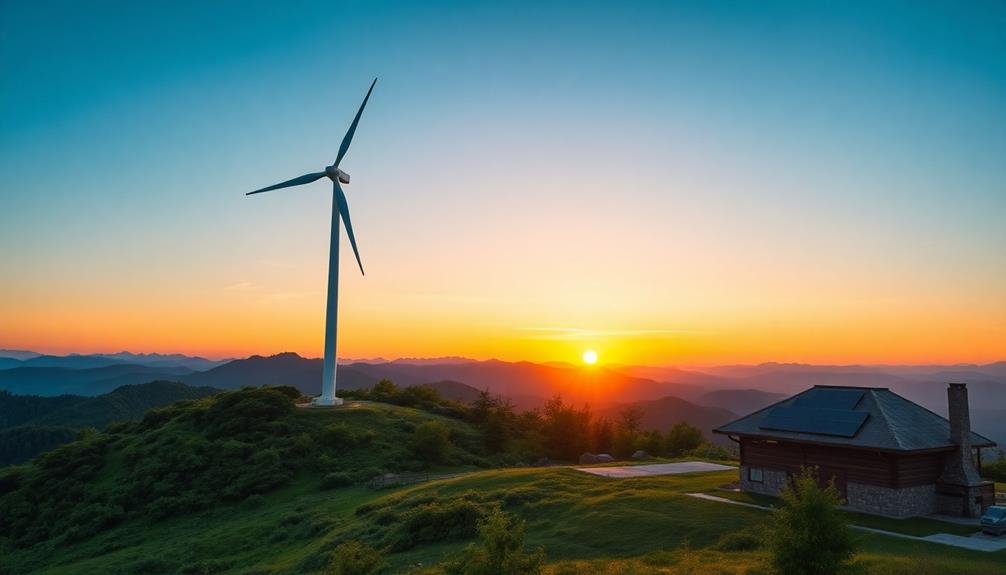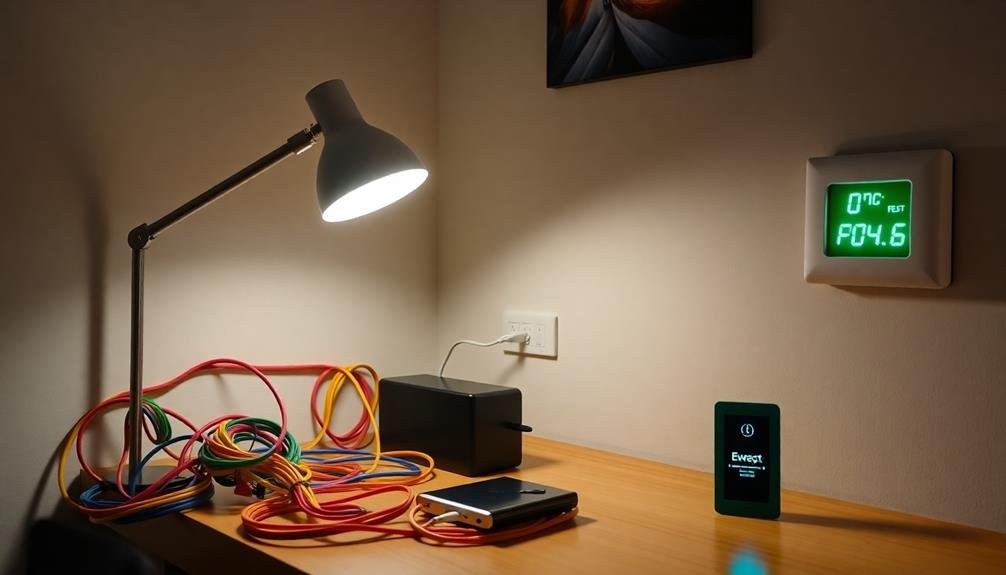For off-grid living, you've got five excellent vertical axis wind turbine designs to evaluate. The Savonius rotor offers simplicity and low-cost construction, ideal for DIY projects. The Darrieus turbine, shaped like an eggbeater, excels in higher wind speeds. Helical blade configurations provide smooth operation and aesthetics. H-type systems offer straightforward maintenance and work well in turbulent conditions. Finally, the Giromill structure allows for blade pitch adjustment, enhancing efficiency. Each design has unique advantages, from low-speed performance to scalability. Exploring these options will help you find the perfect fit for your off-grid energy needs.
Savonius Rotor Design

The Savonius rotor is a simple yet effective vertical axis wind turbine design. You'll find it's especially suitable for small-scale off-grid applications due to its low-cost construction and ability to start at low wind speeds.
The rotor consists of two or more semicircular blades arranged vertically, creating an S-shape when viewed from above. As wind blows across the Savonius rotor, it creates a drag difference between the concave and convex sides of the blades. This differential force causes the rotor to spin, converting wind energy into rotational mechanical energy. You can then use this energy to power a generator or pump water directly.
While Savonius rotors aren't as efficient as some other wind turbine designs, they're incredibly robust and can operate in turbulent wind conditions. They're also quieter than horizontal axis turbines, making them ideal for residential areas.
You can easily construct a Savonius rotor using readily available materials like oil drums or PVC pipes, making it a popular choice for DIY enthusiasts. When considering a Savonius rotor for your off-grid setup, remember that its low-speed, high-torque characteristics are well-suited for water pumping and small-scale electricity generation.
Darrieus Turbine Model
Imagine a wind turbine that looks like an oversized eggbeater. That's the Darrieus turbine, named after its French inventor Georges Darrieus. This unique vertical axis wind turbine (VAWT) design features two or more curved blades that connect at the top and bottom of a central shaft.
You'll find that the Darrieus turbine operates differently from other VAWTs. It uses lift forces to rotate, similar to airplane wings, rather than drag forces. This makes it more efficient than Savonius rotors in higher wind speeds. The curved blades allow the turbine to capture wind from any direction without needing to reorient itself.
While Darrieus turbines can be more efficient, they're not without challenges. They often require a small motor to start spinning and can struggle in low wind conditions.
You'll also need to take into account their height, as they're typically taller than other VAWT designs. Despite these drawbacks, Darrieus turbines remain popular for off-grid applications due to their ability to generate significant power in the right conditions.
They're particularly useful in areas with consistent, moderate to high wind speeds.
Helical Blade Configuration

You'll find that helical blade configurations offer a unique twist on vertical axis wind turbine design. These blades are curved and wrapped around the central shaft in a spiral pattern, resembling a helix. This design addresses some of the shortcomings of straight-bladed Darrieus turbines.
The helical shape distributes the torque more evenly throughout the rotation, reducing vibrations and stress on the turbine's components. You'll appreciate the smoother operation and reduced noise levels compared to other vertical axis designs.
Helical blades also start rotating at lower wind speeds, improving overall efficiency in areas with variable wind conditions.
Another advantage you'll notice is the turbine's ability to capture wind from any direction without needing a yaw mechanism. This makes helical blade turbines particularly suitable for urban environments or areas with turbulent wind patterns.
The aesthetically pleasing design can blend well with architectural elements, making it a popular choice for both residential and commercial applications.
However, you should be aware that helical blade turbines can be more complex to manufacture, potentially increasing costs. They may also have slightly lower peak efficiency compared to some horizontal axis turbines.
H-Type Vertical Axis System
Several key features distinguish the H-type vertical axis system from other wind turbine designs. This configuration consists of two or more straight blades attached to a central vertical shaft, forming an H-shape when viewed from the side.
You'll find that these turbines are relatively simple to construct and maintain, making them a popular choice for off-grid applications.
The H-type system operates effectively in turbulent wind conditions and can capture wind from any direction without needing a yaw mechanism. You'll appreciate its low noise output and minimal visual impact compared to horizontal axis turbines.
These turbines also have a lower center of gravity, enhancing stability and reducing structural requirements.
However, you should be aware of some limitations. H-type turbines generally have lower efficiency than horizontal axis designs, especially in low wind speeds.
They may also experience higher drag forces and vibrations due to their straight blade configuration. To mitigate these issues, you can consider using airfoil-shaped blades or implementing variable pitch systems.
Despite these challenges, the H-type vertical axis system remains a viable option for small-scale wind energy production in off-grid settings.
Giromill Turbine Structure

How does the Giromill turbine structure differ from other vertical axis designs? Unlike the H-type system, the Giromill uses straight blades that can be pitched or adjusted to optimize energy capture. This unique feature allows the turbine to perform efficiently in varying wind conditions, making it a versatile choice for off-grid living.
The Giromill's structure offers several advantages:
- Improved efficiency: By adjusting blade pitch, you'll capture more energy from low and high wind speeds.
- Reduced noise: The blade design minimizes turbulence, resulting in quieter operation compared to other turbines.
- Lower maintenance: With fewer moving parts, you'll spend less time and money on upkeep.
- Scalability: Giromills can be easily scaled up or down to meet your specific energy needs.
You'll find that the Giromill's straight blades are typically made of lightweight materials like fiberglass or carbon fiber. These materials guarantee durability while minimizing the turbine's overall weight.
The central shaft, which supports the blades, is often constructed of steel or aluminum for strength and stability.
With its unique design and adjustable blades, the Giromill offers an efficient and adaptable solution for harnessing wind energy in off-grid settings.
Frequently Asked Questions
What Is the Typical Lifespan of a Vertical Axis Wind Turbine?
You can expect a vertical axis wind turbine to last 15-20 years on average. However, with proper maintenance and care, you'll find that some turbines can operate efficiently for up to 25-30 years before needing replacement.
How Much Noise Do Vertical Axis Wind Turbines Produce?
You'll find that vertical axis wind turbines are generally quieter than horizontal ones. They produce minimal noise, often less than 60 decibels at close range. You won't hear much beyond a gentle whooshing sound during operation.
Can Vertical Axis Wind Turbines Be Installed on Residential Rooftops?
Yes, you can install vertical axis wind turbines on residential rooftops. They're compact and don't need to face the wind, making them suitable for urban settings. However, you'll need to take into account structural support, zoning laws, and potential vibrations.
What Maintenance Is Required for Vertical Axis Wind Turbines?
You'll need to regularly inspect and lubricate bearings, check blade condition, and tighten bolts. You should also clean the blades, monitor the generator, and replace worn parts. Don't forget to periodically inspect the mounting structure for stability.
How Do Vertical Axis Wind Turbines Perform in Extreme Weather Conditions?
You'll find vertical axis wind turbines perform well in extreme weather. They're resistant to high winds and can operate in any direction. However, you should protect them from heavy ice buildup and guarantee proper anchoring during storms.
In Summary
You've now explored five innovative vertical axis wind turbine designs perfect for off-grid living. Whether you're drawn to the simplicity of the Savonius rotor or the efficiency of the Darrieus model, there's a design to suit your needs. Don't forget the unique helical blade, versatile H-type, and adaptable Giromill options. By choosing one of these designs, you'll be harnessing clean, renewable energy and taking a significant step towards sustainable, independent living.





Leave a Reply